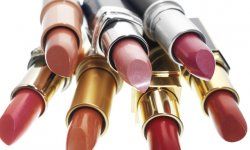Quick quiz: What product, used on the faces of the majority of women in the United States on a daily basis, may contain lead, cow brain tissue or crushed beetle shells? You probably didn't guess that it's lipstick. Gross, huh? Well, according to the U.S. Food and Drug Administration (FDA), there's no reason to worry. The amounts of lead are too small to be of any danger, cow brains from older cows are no longer allowed after the mad cow scare, and the crushed beetle shells are perfectly safe.
Now that you're thinking about lipstick in a new way, let's look at the basics. In short, lipstick is a compressed tube of waxes, oils, additives and pigments that color and moisturize the lips. Most of us lipstick-wearers don't give much thought to anything other than the color, how it feels on our lips and how much it costs. Lipstick can be had for anywhere from $1 to $100, depending on the brand. One lipstick made by Guerlain costs more than $60,000, but that's probably because of its diamond-encrusted, 18-karat gold tube (we hope).
Advertisement
Although there are many different types of lipsticks and a vast array of colors, there are some basic ingredients. And that list of ingredients above is just a paltry few of the many substances that might be in the tube of lipstick in your purse. For many women, wearing lipstick for the first time is a rite of passage, and even if they wear no other makeup, they feel naked without it. Lipstick essentially began the modern cosmetics industry.
The word "lipstick" can mean a lot of different things. Let's start with looking at the difference between a matte and a stain, and find out how some lipsticks can stay looking great throughout the day without any touch-ups.




